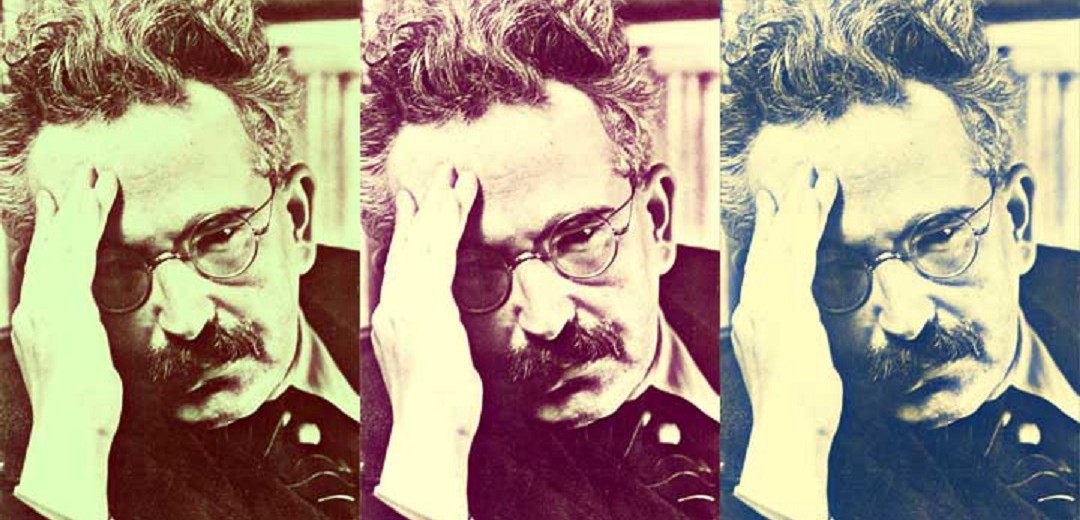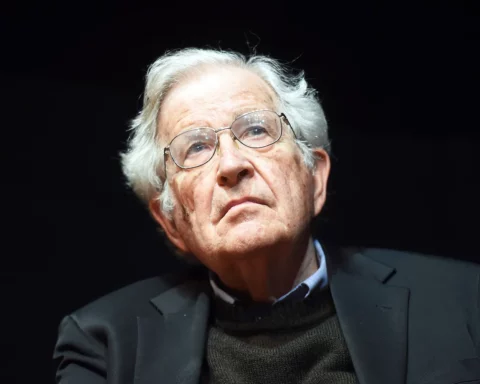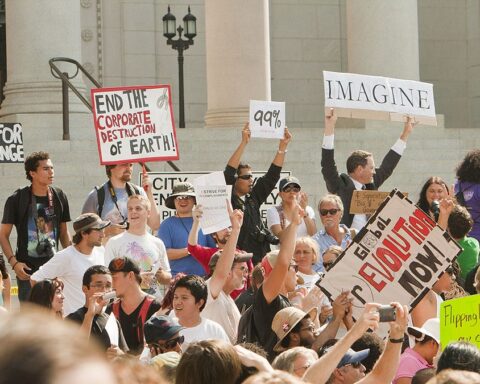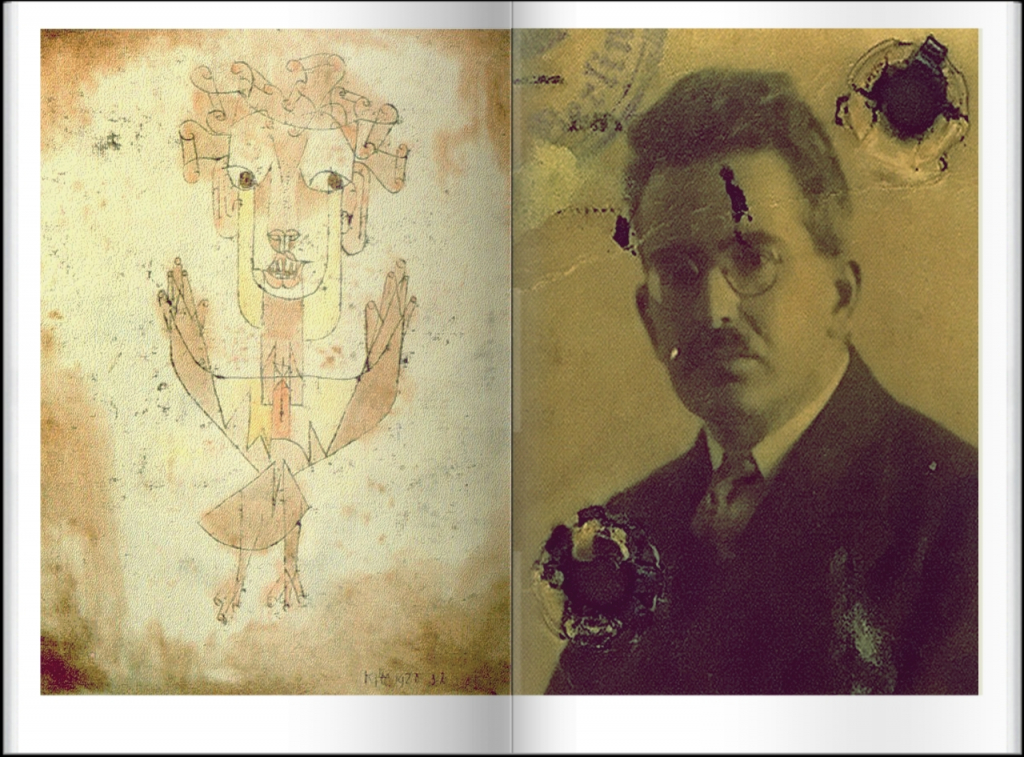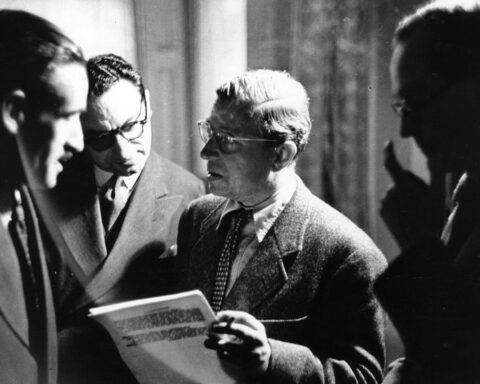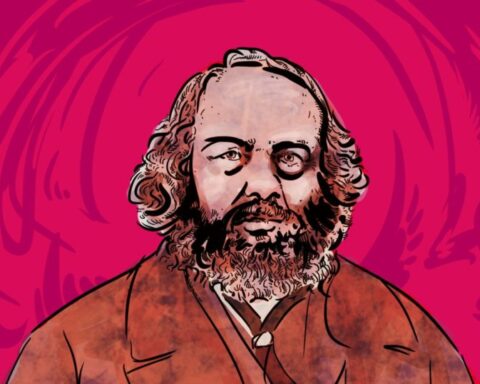Walter Benjamin’s relevance for activists today is most strongly felt in his works on social transformation. In the sixth of eight pieces on Benjamin, Andrew Robinson explores the Theses on History, and discusses the revolutionary implications of allegory, collecting, citation, DIY, and time.
Benjamin’s “On the Concept of History”, also known as “Theses on History” and “Theses on the Philosophy of History”, deals with the question of social transformation. This insightful short work is one of Benjamin’s best-known and most cited works. Of all his works, it develops Benjamin’s messianic ideas most completely.
The theses can be summarised as follows:
Thesis 1: Benjamin suggests that Marxism relates to theology much as an automaton relates to its operator. Despite its illusory determinism, Marxism is really articulating a theological response to capitalism-as-religion (see below).
Thesis 2: Every generation is endowed with a ‘weak messianic power’, because every past generation hoped for redemption or resurrection in the future. Benjamin implies that present revolutions ‘redeem’ or continue past revolutions – there is a line connecting them which is not that of linear time.
Thesis 3: Nothing is completely lost to history, but the past is comprehensible only from the position of redemption.
Thesis 4: The ‘spiritual’ is present in class struggle – even when it is about material things – as the drive towards redemption.
Thesis 5: The truth of the past is visible only as a tentative image which threatens to slip away. This image, presumably, is apparent in the continuity between past and present struggles.
Thesis 6: A revolutionary historian should not focus on ‘how it really was’, but rather, on seizing the image as it flashes by. This means one should seek to rescue ‘tradition’ from a ‘conformism’ which threatens to overwhelm it. The task is to set light to the sparks of hope in the past. On the other hand, the past is not safe from a victorious enemy. Today, images of the past threaten to disappear if the present does not recognise them.
Thesis 7: Current rulers are always the inheritors of the series of victories, and the guilt of past rulers. Every achievement of civilisation or culture is marred with barbarism, with the suffering of the exploited and excluded. The cycle cannot be broken by victory. This claim is based on Benjamin’s discussion of law as fate. The only way to escape such ongoing guilt is to ‘brush history against the grain’. This also means to be in continuity with the defeated of the past.
Thesis 8: The state of emergency is not an exceptional, but a normal situation (this idea is expanded by Agamben). The rise of fascism requires the rejection of an idea of ongoing progress. Instead, revolution is directed against the current direction of history. The claims in theses 7 and 8 are critiques of the Marxian view of the ascension of humanity through progressive historical stages. As Benjamin argues elsewhere (in Central Park), Hell is not something to fear in the future, but is already present. The catastrophe is not around the corner if the system collapses. The catastrophe is the continuation of things as they are.
Thesis 9: Benjamin here analyses Klee’s painting Angelus Novus. This work of modern art is characteristically ambiguous, allowing the viewer to construct meanings from it. Benjamin sees it as depicting the Angel of History, looking back to the past. The Angel sees, not progress, but a growing pile of rubble. The Angel desires to redeem and put back together what is broken. But s/he is unable to do so because of a ‘storm blowing from Paradise’. This storm is what is called ‘progress’. In this analysis, Benjamin suggests a powerful image of history as an accumulation of ruins. He suggests that the power to resist this cumulative worsening is simultaneously ruptural and healing. Elsewhere he metaphorises it as pulling a stop-chord on a runaway train – the present system is a train with broken brakes, speeding towards disaster, and the messianic moment is like a stop-chord. In another passage, history is awakened with a slap born of long-contained frustration, not a kiss.
Thesis 10: Benjamin desires to make the current world and its drives repugnant, and critcises socialist politicians for their attachment to the goods of the present.
Thesis 11: Benjamin offers a critique of social-democracy for the idea of progress. The view of modernisation as progress is taken to ignore the effects of produced commodities on workers. It produces a corrosive conformity to the present, and lays the seeds for fascist technocracy. Here, Benjamin also contrasts the exploitation of nature to the release of its potentialities.
Thesis 12: Revolution avenges past generations. Progressivism reduces it to the salvation of future generations, and thus loses its ‘hate’ and its ‘spirit of sacrifice’ – which it needs.
Thesis 13: The idea of progress is inseparable from the idea of homogeneous empty time.
Thesis 14: The transformation of history does not occur in homogeneous empty time. It occurs in moments of immediacy (jetztzeit). It blasts particular moments of the present and past out of the linear sequence (and presumably the order of fate).
Thesis 15: Revolutions are necessarily experienced as rupturing the continuity of history.
Thesis 16: The present is not a transition between moments. Time originates and reaches a standstill in the experience of the present. Instead of an eternal past depicted as linear, we need a ruptural experience of particular moments which stand out. (This suggests an expressive relationship to temporal experience).
Thesis 17: The difference between progressivist and truly Marxist theories of history is that the former lists dates whereas the latter constructs time from a structure. The structure is based on the idea of a messianic zero-hour in which thought concentrates into a monad. This messianic moment explodes particular epochs, lives, or works out of linear history.
Thesis 18: Human existence is itself like a messianic zero-hour in the entire history of Earth.
Addendum A: Past events are given their historical meaning retrospectively, in messianic moments.
Addendum B: Awaiting redemption prevents time from becoming homogeneous and empty.
Analysis of the Theses
The most notable aspect of the theses is that they provide the clearest statement of Benjamin’s non-linear conception of time. Homogeneous empty time is associated specifically with capitalist effects on experiences of time. This is radical in its implications. Most everyday experiences of time are problematised as effects of capitalism. This is confirmed by studies suggesting that non-capitalist social groups experience time differently – as natural cycles rather than interchangeable instants, for example. Benjamin suggests that time would formerly be ‘filled’ by festivals and memorial days, creating connections between moments through time.
Homogeneous empty time is the kind of time measured by clocks and calendars. In homogeneous empty time, every moment of time is equivalent and empty. It is homogeneous because one “day” or “minute” or “hour” is treated as equivalent to any other. It is empty because, on the whole, it lacks special moments which give it meaning (in contrast to cyclical, ritual and biological time). It simply passes, and people fill it with contingent contents.
Homogeneous empty time passes in an eternal present which remains fundamentally the same. The new reproduces the old in a series of structurally similar moments. This experience of time arises from the constant replacement and renewal of commodities. People experience time this way because of its technological and social underpinnings in the capitalist way of life. In the Arcades Project, Benjamin associates homogeneous empty time with boredom.
The critique of homogeneous empty time has inspired authors studying phenomena such as nationalism and capitalism. Benedict Anderson’s ‘Imagined Communities’ shows the ways in which national identity, and modern cultural forms such as the novel and newspaper, depend on homogeneous empty time as an underpinning. E.P. Thompson shows how the imposition of homogeneous empty time was crucial to the creation of capitalist work-discipline when the working-class was first formed. Scholars working on global modernity often portray homogeneous empty time rubbing up against other, historically rooted ways of experiencing time.
Benjamin’s theory also resonates with Marx’s discussions of the importance of labour-time in commodity-production. Labour and commodities are only exchangeable because they can be treated as equivalent – and they can only be treated as equivalent because units of time are treated as identical. Commodity fetishism depends on homogeneous empty time. Homogeneous empty time is also associated with the closed world of fate and guilt.
Benjamin goes further than simply criticising capitalist forms of time. He suggests that excluded groups and revolutionaries can access another way of experiencing time, even in capitalist contexts. He suggests that the ‘messianic’ moment exists as a form of time.
This other kind of ‘messianic’ time is associated with the experience of immediacy, and the creation of non-linear connections with particular, past or future points. The present revolt is connected in spirit to past revolts. The present generation of activists is always potentially the messiah which past revolutionary movements were waiting for. If our own resistance ‘fails’ in the present, it may nevertheless be redeemed by some future movement, and is not in vain – unless the system wins so absolutely that the past is also ‘lost’.
Some similarities and differences can be listed as follows:
Homogeneous empty time is quantitative; messianic time is qualitative.
Homogeneous empty time is a continuous flow; messianic time is fully immediate.
Homogeneous empty time is experienced as anaesthetising, desensitising and meaningless. Messianic time is experienced as emotionally intense, like a drug high. It is filled or fulfilled.
Homogeneous empty time is continuous; messianic time is ruptural.
Homogeneous empty time is meaningless (empty); messianic time is the time of a ‘specific recognisability’ – it means something specific to those who experience it.
This view of time also suggests the possibility of ‘newness’ in history. The moment of messianic rupture – redemption or revolution – is also a moment when past debts and complicities are cancelled-out. This should be cross-read with the idea of law-destroying violence. By destroying the ability to enforce hierarchical exclusions and binaries, law-destroying violence ends the reign of fate. As expressive violence, law-destroying violence is ‘non-violent’, destroying the possibility of instrumental violence and therefore the ongoing complicities in past oppressions. This possibility is more radical than those considered by most poststructuralists.
In Esther Leslie’s reading, Benjamin sees messianic time filling the place left empty by capitalism. Capitalism sucks memory out of everyday life, leaving a space which messianic time can enter. Similarly, Gibbs argues hat messianic time unsticks the present from its seemingly necessary future. Instead, it establishes continuities with other, subterranean histories.
The revolutionary presence of now-time – jetztzeit – blasts open the linear continuum of history. In German, Benjamin contrasts jetztzeit or jetztsein – the present as ‘now’, as immediate – with erlebnis – the present experienced as if already past, as a moment in a process. This idea of immediacy is similar to that of Hakim Bey, and to accounts of the immanence of activist subjectivity, such as Peterson’s.
A revolutionary moment is a moment when messianic time enters and explodes homogeneous empty time. In such a moment, the whole of time is experienced as a monad. It is as if all life is reconciled and compressed into a single moment. The implication is that every singularity is brought into the new future, but minus the existing relations among different things. This moment is accessed through the dialectical image or profane illumination. ‘Truth’, in an expressive sense, appears in such moments. It causes things to leap out of their context.
The messianic moment also ruptures things from their particular locations in an order of things. Objects, ruins, ideas and language become rearticulable, or can be ‘redeemed’ (something Benjamin also relates to allegories, collecting, and non-standard uses). An old factory is ‘redeemed’ as a squat, a commodity is ‘redeemed’ as meaningful to a collector, a word is ‘redeemed’ by being used allegorically. A date such as Mayday, or November 17th in Greece, can capture a range of historical precedents and ‘redeem’ them in present revolt, ignoring the time-lapses inbetween.
The potential of allegory and montage is to seize upon the fragments of an experience which is already fragmenting, so as to create recognition or insight; the potential of collection is to rearrange objects in an esoteric world of their own. This removes the taint which the system (as order of things) otherwise places on objects, language and so on. Hence Benjamin is suggesting the possibility of a non-binarised, open-ended relationship to the world which occurs through praxis. This corresponds to the desire of the Angel of History to put back together the ruins left behind by history.
In writing, this “putting back together” occurs through the arrangement of references. For Benjamin, all texts are actually composites of different citations, or intertextual references. Every text is like a montage. In One-Way Street, Benjamin describes quotations in his work as akin to robbers, who leap out and rob the reader of her/his convictions.
In the article ‘Unpacking my Library’, Benjamin discusses the relationship of a collector to objects which are collected. Crucially, collecting is about liberating objects from their status as commodities or as instrumental objects for use. Instead, the collector places objects in a kind of magical arrangement. Collecting is thus a way of renewing the world. An object acquired for the collection is ‘reborn’ into it. The collector feels responsible towards the objects, rather than the reverse. Further, the collector comes to life in the objects. A collection exists between order (the arrangement of objects) and disorder (the passion for collecting). It is a passionate phenomenon. Collecting creates a mood of anticipation, and always carry memories from the moments of acquisition.
In One-Way Street, Benjamin re-enchants stamp-collecting via the idea of the postmark marking the face with weals or cleaving a continent like an earthquake. The collection of stamps can inventory places and dates in magical ways, and capture part of the power of great states.
In language, redemption occurs by way of allegory, or symbolic representation. Allegory overfills the present by filling it with a flash from the past. Allegories are akin to ruins. They are what is left when meaning or life is lost. It provides a vision of time and history which shows them in ruins. It also has a power to make anything mean anything else. Through allegory, the present is reconstituted as ‘expected’ – as the messianic moment which redeems the past. The way to make past phenomena present is to resituate them in the present space, connecting them to the present as a constellation.
In discussions of the poet Baudelaire, Benjamin celebrates the power of allegory. Allegory, according to Benjamin, stems from the gaze of an alienated viewer. It arises from flânerie. The flâneur stands at the margins of the bourgeois city. Intellectuals in particular were drawn into this stance by the precarity and uncertainty of their social position, creating the phenomenon known as ‘Bohemia’. Pre-Marxist revolutionary conspiracies emerged from the ‘rebellious pathos’ of this group, its ‘asocial’ stance. But flânerie is recuperated in the form of the department store. It was the means whereby intellectuals were ultimately brought into the market.
In the seventeenth century, allegory was the usual basis for the dialectical image – in this case, the perception of alienation. In the nineteenth century, when Baudelaire was writing, it was nouveauté(novelty). Nonconformists opposed the commercialisation of art and called for ‘art for art’s sake’ (perhaps seeking to preserve the aura of art). Benjamin sees this as a step backwards. The nonconformist as much as the commodifier ignored social phenomena. Ultimately, this view of art leads to epic delusions. Benjamin later connects this approach with the rise of fascism.
In relation to qabalah, Benjamin shares the idea that messianism can only be experienced outside the existing world. It requires us to turn away from the affairs of the world, as in a monastic withdrawal. But Benjamin’s withdrawal is more active. He is calling for the messianic moment to be experienced and used to transform the world.
Revolution is thus a kind of transubstantiation. A substance of one kind – commodities, homogeneous empty time, ordinary language – is transformed into another. It is the end of homogeneous empty time and of commodity fetishism.
It is also called ‘discovering the new anew’. Capitalism always presents us with the new, but the capitalist new is a return of the same. The new discovered anew is the possibility of radical novelty which is not a return of the same.
However, Benjamin is inconsistent regarding the extent to which messianism is realisable. In the ‘Theologico-Political Fragment’, Benjamin argues that the messianic moment consummates history, and is therefore necessarily incommensurable with it. The historical world therefore cannot be built on a divine or messianic model. It should be built on a model of happiness instead. This pursuit of happiness both contradicts and assists the messianic moment. Messianism is also the passing-away of the world. How can this be reconciled with the revolutionary role of messianism? It is possible that Benjamin saw messianism as a means of rupture between two ‘historical’ worlds, or that he simply changed his mind. I wonder, however, if the issue has more to do with how messianism can be used – in particular, an insistence that it must be lived in immediacy, and that politicians must not claim ‘divine’ authority for themselves.
The idea of ‘redemption’ in Benjamin’s work stems from his theory of messianism. Objects are redeemed by being used in alternative ways, distinct from their usual connections, and especially their exchange-values and their sign-values (e.g. as fashionable). This might be termed a bricolage or deconstruction of objects. Many examples can be found in the practices of squatters and other activists, in terms of the DIY reconstruction of everyday objects for new purposes – old stereos rescued from the roadside and reconfigured, scrap materials used in artworks and so on. One might think of this in terms of a ‘just in case’ rather than ‘just in time’ approach to objects, resonant with local knowledge and resilience rather than commodity systems.
Language is similarly transformed through allegory and translation. Technology also contains such potentials, revealed by children’s playful associations, designers’ fantasies and so on. Traditions of literature and theory can also be renewed through creative applications which are not confined to repetition.
Another important insight is the view that Hell or disaster is now. The theme of impending disaster is important both to reactionaries (the pending Hobbesian chaos if the system collapses) and to many progressives. Yet modernity already provides impending and ongoing disasters. Benjamin has in mind fascism and the First World War. Today we could also include nuclear weapons, ecological collapse, deaths due to capitalist enclosure in the South, the atrocities committed in the ‘war on terror’ and in many small wars worldwide, and maybe even 9/11.
It is common for such disasters to be portrayed as a violent eruption of an ‘outside’, which breaks into the otherwise peaceful development of (white, Northern) humanity. Benjamin reverses perspective, seeing such events as the Hell of the present. Benjamin seems to be seeing the ‘present’ in process here, so future disasters (World War 2 for Benjamin; today, such dangers as climate change, global war and increasingly dystopian regimes of social control) are extensions of the present, not threats to it. To stop these effects of the dominant system, it is necessary to put the brakes on it. Hope appears, not in what history brings, but in what arises in its ruins.
Benjamin here rejects the idea of progress as the extension or defence of elements of the existing situation. Instead, the messianic moment – Benjamin’s substitute for progress – is a radical interruption of the present. The messianic moment is in a sense radically exterior to the history it interrupts.
The idea of a permanent state of emergency is connected to this sense of ongoing disaster. Benjamin extends and criticises Carl Schmitt’s view, in which the state of emergency is the way the state (or ‘sovereign’) maintains its power in a context of contingency. Benjamin uses the idea of emergency to criticise, rather than reinforce, the social order.
There are both everyday and eruptive aspects to the implications of Benjamin’s critique. On an everyday level, Benjamin’s approach points towards activist practices of reappropriation of spaces and objects – squatting, DIY, bike repair, guerrilla gardening, home construction for projects such as pirate radio, and so on. He also implicitly endorses ‘subvertisement’, parody and other such symbolic means of disrupting established connections.
But he also seems to be calling for a moment of decisive rupture – a total insurrection, a Sorelian general strike, or a general movement of exodus. It is unclear how these two aspects of his project fit together. I would suggest that the messianic moment can occur firstly as an individual or small-group realisation, but that it can “redeem” the world only if it expands its scope.
Capitalism as Religion
The Theses on History provide a theological response to capitalism, because for Benjamin, capitalism is religious in nature. In ‘Capitalism as Religion’, Benjamin argues that capitalism did not simply stem from Protestantism (as Weber argued), but is a religion in its own right. It developed parasitically by attaching itself to Christianity. Firstly, it reduces all of existence to its own standards of value. Secondly, it colonises all of time with this regime of value, as if every day were a day of worship. Thirdly, it is a cult based on guilt and blame (not repentance). It declares everyone to be guilty. It is a ‘cultic’ religion, of ritual practices, without ‘dogma’ or religious doctrine. Objects such as banknotes carry religious symbolism. It is an unusual religion because it offers not transformation but the destruction of existence. It flourishes on anxiety or ‘worries’, which ‘index the guilty conscience of hopelessness’.
Benjamin criticises Nietzsche and Freud for accepting what he takes to be aspects of the capitalist religion – Nietzsche because of the absence of a transubstantiation or messianic moment, Freud for reproducing capitalism in the unconscious. A rather literal activist equivalent of this reading of capitalism is offered by the performance activist Reverend Billy, who parodies traditional religious practices as means to protest against consumerism.
source: https://ceasefiremagazine.co.uk/walter-benjamin-messianism-revolution-theses-history/
